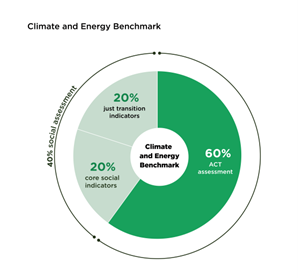
Methodology
Introduction
The 2024 Climate and Energy Benchmark assessing the heavy industries is the first iteration which brings together the assessment of companies’ climate strategy and performance together with social performance in the same benchmark. The performance on climate is examined through an Accelerate Climate Transition (ACT) assessment. Social performance is examined through the just transition indicators (JTI), and core social indicators (CSI). For more details on the methodology please see the methodology report below.
See the methodologyScope
The aluminium, cement and steel industries are a hard to abate in terms of emissions but at the same time crucial to produce the materials the energy transition depends upon. Steel demand for the wind industry is surging and aluminum is crucial for EV batteries enclosures and charging stations.
Therefore, it is crucial to assess how keystone companies in these segments are preparing for the transition and understand which type of future they are locking us into. The benchmark accounts for most of the emission-intense activities along the respective value chains together with a view into the maturity of planning, investments and low-carbon business models of companies. Consequently, companies from this sector are highly relevant to be included in WBA’s benchmarking process.
The 2024 Heavy Industries Benchmark assesses a total of 91 companies operating in the aluminium (12), cement (34) and steel industries (45). Together, the operational emission of the company selection amounted in 2022 to approximately 7% of the world’s global energy-related emissions (IEA 2022) and 28% of the emission originating from the industry sector a whole (IEA 2023). For this benchmark, we will assess the heavy industries sector considering three different ACT methodologies based on the scope of companies’ activities:
- The ACT Aluminium methodology applies to companies involved in producing aluminum or alumina.
- The ACT Cement methodology applies to companies that involved in producing cement. The main sources of emissions from the cement industry are the production of clinker and the blinding and griding operations.
- The ACT Iron and Steel methodology applies to companies involved in steel making (including the production of iron) and/or steel products shaping activities.
Approach to scoring and ranking
ACT assessment
A score is given per indicator which is used to calculate the performance element of the ACT score. The narrative assessment is then produced by analysing the company against the four narrative criteria. Data from the performance assessment as well as other verifiable public data on the company such as annual and sustainability reports and news from reliable sources is considered. Finally, the trend score is produced synthesising the forward-looking aspects of the assessment to consider whether the company’s performance would improve, stay the same or worsen if assessed again in the near future.
To create the ACT rating score, a weighting was applied to each of the performance, narrative, and trend scores as follows:
- The performance score has a 1:1 weighting, i.e., a score of 12 is 12;
- The narrative score is weighted: A=20, B=15, C=10, D=5, E=0; and
- The trend score is weighed: “+”=2, “=”=1, “-“= 0.
Social transformation assessment
The just transition methodology is based on 6 indicators (JTI), which are all scaled on 2 points. JTI 1 and JTI 2 are double-weighted while all other ones (from JTI 3 to JTI 6) are single-weighted.
The core social indicators (CSI) are scaled on 1 point. They all are single-weighted, except CSI 4 and CSI 5 which are double-weighted.

Figure: Total benchmark ranking scores
Aggregation of scores
ACT, CSI and JTI scores are set to 60%, 20% and 20% of the total score respectively. This overall weighted score results in the Heavy Industries Benchmark 2024 ranking.
Total figures for assessments can be subject to rounding differences, but this has not had any overall effect on the ranking.
See our FAQsData collection process
The Heavy industries Benchmark 2024 assesses the most reliable, latest available, public and verifiable data. Trends in past performance of the company are analysed over five years before the reporting year. Published data until 31st December 2023 was used for the assessment, meaning quantitative datapoints were taken from 2017 to 2022.
Data was collected in the first instance from company’s public annual reports and publicly available information, including company websites, sustainability and corporate responsibility reports. Data from the company’s public CDP disclosure was also retrieved and used in the assessment. For asset-level evaluation emissions data from Climate Trace and the Global Energy Monitor was sourced.
Companies were also invited to directly participate in the data validation process by submitting information during a two–week period in February 2024 and this was further extended to the 18th of March.
All 91 companies were invited to provide additional information; 7 companies provided additional data either through the data validation process or by other means within the time period.
See data set